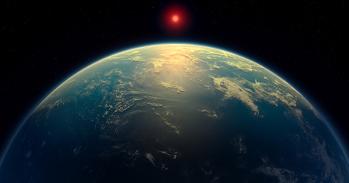
Cosmic defects and adolescent galaxies – two research projects in Cambridge are bringing us closer to understanding the cosmos.
Cosmic defects and adolescent galaxies – two research projects in Cambridge are bringing us closer to understanding the cosmos.
it will revolutionise our understanding of how the fundamental symmetries between the particles and forces were broken as the universe emerged from the Big Bang.
Professor Neil Turok
Astronomers believe that the universe was created 13.7 billion years ago following a cosmic explosion, the residual energy of which can still be detected as cosmic microwave background (CMB) radiation, which fills the universe. The matter hurled outwards from the fireball eventually cooled enough to form galaxies across the expanding universe.
Cambridge scientists working with the Institute of Physics of Cantabria in Spain may have discovered a remnant in the CMB from the Big Bang called a ‘texture’. As the universe cooled and underwent transitions, physicists believe that vacuum misalignments or defects occurred. An analogy would be the defects we sometimes see in the transition of water to ice. Textures are one of the most complex of cosmic defects, and when they collapse they form ‘hot’ and ‘cold’ spots in the CMB.
The team have analysed a large cold spot in the Southern Galactic Hemisphere and published their findings recently in Science. Professor Neil Turok, of the Department of Applied Mathematics and Theoretical Physics (DAMTP), and Dr Mike Hobson, of the Astrophysics Group at the Cavendish Laboratory, concluded that the properties of the cold spot are consistent with its having been formed by a texture. ‘If this is the case,’ said Professor Turok, ‘it will revolutionise our understanding of how the fundamental symmetries between the particles and forces were broken as the universe emerged from the Big Bang.’ Professor Turok was awarded the prestigious Technology, Entertainment, Design (TED) prize in November in recognition of his work in cosmology and his efforts as an education activist. The prize is awarded annually to three individuals whose work is considered to have extraordinary potential for positive influence on mankind.
About half a billion years after the Big Bang, it is thought that matter started to aggregate, eventually forming small adolescent proto-galaxies, which then merged to become bigger galaxies. Although astronomers have been able to study starlight of the progenitors of very massive galaxies, starlight from the building blocks of galaxies like our Milky Way has proved elusive. In a recent study, due to be published in March in the Astrophysical Journal, an international team of astronomers led by Dr Martin Haehnelt at the Institute of Astronomy were able to capture starlight from 27 adolescent galaxies about 2 billion years after the Big Bang. They pointed the world’s most powerful telescopes, located in Chile, to the same patch of sky for the equivalent of 12 nights. ‘It is precisely because this was the first time the sky had been searched with this level of sensitivity that we succeeded where many astronomers had failed before,’ said Dr Haehnelt. The detection of these building blocks means that scientists can now study in detail how galaxies like the Milky Way have come together.
For more information, please contact Professor Neil Turok(N.G.Turok@damtp.cam.ac.uk), whose research was published in Science (2007) 318, 1612–1614, or Dr Martin Haehnelt (haehnelt@ast.cam.ac.uk).
This work is licensed under a Creative Commons Licence. If you use this content on your site please link back to this page.





